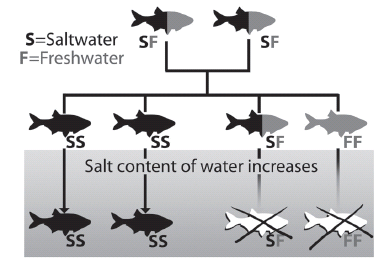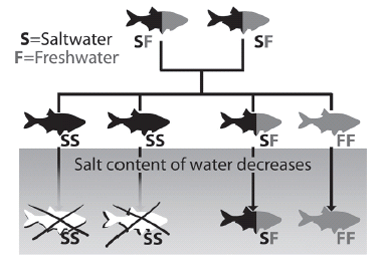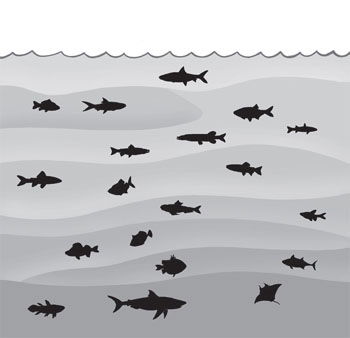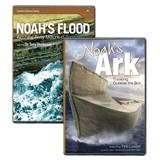
Chapter 20
How Could Fish Survive the Genesis Flood?
Some skeptics and long-age Christians lampoon the biblical account of the global Genesis Flood cataclysm by insisting that it was impossible for Noah to have a giant aquarium aboard the Ark to preserve all the marine creatures, including trilobites.1 However, this accusation is of course easily dismissed, because a careful reading of the relevant biblical text (Genesis 7:13–16, 21–23) clearly shows that God only brought to the Ark representatives of all the created kinds of air-breathing, land-dwelling creatures. After all, the water-dwelling creatures would surely have been able to survive in the Flood waters.
Obviously, the air-breathing, land-dwelling creatures could not have lived through the earth-covering global Flood, but one would think the aquatic animals would have been right at home in all that water. Perhaps not, however, if during the Flood there was mixing of fresh and salt waters. Yet even that is uncertain, because we don’t know how much mixing of fresh and salt waters would have occurred during the Flood. What we do know is that many of today’s fish species, for example, are specialized, so they do not survive in water of radically different saltiness from their usual habitats. So how did freshwater and saltwater fish survive the Flood?
Saltiness of the Pre-Flood Ocean
To begin with, we do not know how salty the oceans were before the Flood, although early in the fossil record of the Flood we find echinoderms that could have only lived in a salty pre-Flood ocean. What we do know is that if at creation the oceans originally were totally freshwater, then at the current estimated rate of salt build-up in the oceans, all the salt in the oceans would have accumulated in only about 62 million years.2 Of course, this assumes that the salt accumulation has always been at today’s rate.
However, in the biblical account of earth history we are told that the Flood was initiated by the breaking up of the “fountains of the great deep
” (Genesis 7:11), which likely were huge outpourings of hot water and steam that burst from inside the earth, associated with cataclysmic volcanic eruptions.3 Such waters today are very salty, because of dissolved minerals in them. Furthermore, toward the end of the Flood there was massive erosion of the new continental land surfaces as the flood waters drained back into the new ocean basins, thereby carrying a lot more salt with them.
So the oceans before the Flood were a lot less salty than they are now. And since salt has not been added to the oceans uniformly through earth history at today’s estimated rate, their current saltiness accumulated in far less than 62 million years.
However, this is still assuming freshwater oceans to begin with! We cannot, of course, be sure, because the Bible is silent about the salinity of the ocean waters at the conclusion of the creation week. We are told that when God created the earth on Day One, it was covered in water, which He divided on Day Two. It may be safe to assume this was all freshwater because Genesis 1:2 reveals this water was formless and “empty
” (perhaps meaning void or pure).
However, on Day Three God raised the land, and the covering waters were gathered together to form the seas.4 Thus the earth’s land surface was shaped by erosion by these retreating waters, no doubt carrying salts with them. So it’s possible a lot of salt may have been introduced to the pre-Flood oceans by this means.
God created animals suitable for mild salinity, but with the information available to survive in both extremes (freshwater and even more saline water).
Then God created marine creatures on Day Five to live and thrive in those ocean waters, so they must have been created with the ability to tolerate the salty oceans, just as marine creatures are able to today. Thus salt tolerance was not an outcome of the biological changes we are told occurred as a result of the Curse, being instead an ability given marine creatures at their creation by the Creator. Indeed, it was much more likely that God created animals suitable for mild salinity, but with the information available to survive in both extremes (freshwater and even more saline water).
Water Conditions in Which Fish Survive
Living in water requires specific physiological and ecological capabilities, different to those of terrestrial organisms.5 Thus, for example, freshwater fish tend to absorb water because the saltiness of their body fluids draws water into their bodies (by osmosis), whereas saltwater fish tend to lose water from their bodies because the surrounding water is saltier than their body fluids.
The global scale of the Flood cataclysm produced gigantic problems affecting the very survival of many species. Indeed, the fossil record contains many groups of aquatic organisms that became extinct during the Flood deposition of the sedimentary rock layers.6 Some organisms would have simply succumbed to the trauma of the turbulence, being swept away and effectively buried alive.7
Others would have found their suitable living spaces destroyed, and hence died for lack of appropriate habitats. Too much freshwater for marine-dependent organisms or vice versa would have killed those unable to adapt. However, not only are there such salt versus freshwater problems for aquatic organisms, but also problems of temperature, light, oxygen, contaminants, and nutritional conditions.
To simplify this discussion, only the three main factors affecting survival will be highlighted, primarily with respect to fish—salinity, temperature, and turbidity.
Salinity

Many of today’s marine organisms are able to survive large salinity changes, especially estuarine and tidal pool organisms. For example, starfish can tolerate indefinitely seawater with salt concentrations as low as 16–18 percent of the normal level.8 Barnacles can withstand exposure to less than 10 percent the usual salt concentration of seawater.
Fish, as with all other marine organisms, however, have a problem balancing the fluids outside their bodies with those inside. Freshwater fish are constantly adding too much fresh water to their bodies from food, drinking water, and tissue transfer. On the other hand, marine fish get too little fresh water to maintain their fluid balance, due to the large salt input in their drinking water and the constant osmotic pressure to draw fresh water out of their tissues into the surrounding sea water.9
The kidneys and gills are used by fish to manage this balance. If a freshwater fish takes in too much water, then its kidneys secrete as much water as possible, while retaining the circulating salts. Marine bony fish get rid of excess salts largely through their gills, and conserve internal water through resorption. Saltwater sharks have high concentrations of urea in their blood to retain water in the saltwater environment, whereas freshwater sharks have low concentrations of urea to avoid accumulating water. When sawfish move from saltwater to freshwater they increase their urine output 20-fold, and their blood urea concentration decreases to less than one-third.10
There are migratory fish that travel between salt and freshwater. For example, salmon, striped bass, sea-run trout, and Atlantic sturgeon move from seawater to freshwater to spawn, but they return to seawater to mature. Eels do just the opposite, reproducing in saltwater but growing to maturity in freshwater streams and lakes. Obviously, all these fish are able to reverse their removal of water and salt by osmotic regulation according to the amount of salt in their environment. On the other hand, sunfishes and cod remain in freshwater and seawater, respectively, for their whole life cycles. Such fish have very narrow limits of salt tolerance, beyond which the environmental conditions are lethal to them.11

Within many families of fish there is much evidence of hybridization, suggesting that these families may represent the biblical created “kinds.” In most families of fish alive today there are also both freshwater and saltwater varieties12 (“species” in the man-made classification system)—for example, toadfish, gar-pike, bowfin, sturgeon, herring/anchovy, salmon/trout/pike, catfish, clingfish, stickleback, scorpion-fish, and flatfish. This suggests that the ability to tolerate and adjust to large changes in water salinity was probably present in most fish at the time of the Flood.
We have to also remember that there has been some post-Flood specialization in some fish “kinds.” For example, the Atlantic sturgeon is a migratory salt and freshwater species, but the Siberian sturgeon (a different species in the same “kind”) lives only in freshwater. Natural selection has probably resulted in the loss of the ability to tolerate saltwater.
Furthermore, hybrids of freshwater trout and migratory salmon are known, suggesting the differences between freshwater and marine fish may be quite minor. Indeed, the physiological differences may only be largely differences in degree rather than in kind. Many of today’s fish species have the capacity to adapt to both fresh and salt water within their own lifetimes. This is why major aquariums are able to house freshwater and saltwater fish together, by using this ability of fish to adapt to water of different salinity from their normal habitats.
Temperature
The range of temperatures tolerated by fish varies from species to species and their habitats. Some fish have a very narrow range of temperature tolerance in cold, warm, or hot water. Other fish tolerate a wide range of temperatures, from freezing to hot waters (0–32°C, 32–90°F). Stages in the development of juvenile fish are frequently limited by the same narrow range of temperatures required by the adult fish.
Most fish species, including cold-water types, can tolerate at least brief exposure to warm water at 24°C (75°F) and colder water approaching 2°C (36°F), as long as there are prolonged acclimation periods (several days to weeks). The preferred temperature ranges for some representative adult fish are: trout 16–21°C (61–70°F), sunfish 16–28°C (61–82°F), catfish 21–29°C (70–84°F), eel 16–28°C (61–82°F), and codfish 12–16°C (54–61°F).13
It should be emphasized that these abilities pertain to fish today. These fish species have probably been naturally selected within their kinds since the Flood and may have lost much of their original ability to survive in more extreme temperature ranges.14 It makes more sense to postulate that God created fish to survive in moderate temperatures, with the genetic information available to subsequently select for survival in various more extreme environments.
Turbidity
Organic particles, dust and fine silt, bacteria, and plankton that are usually in suspension in natural waters are measured photoelectrically as turbidity. Such materials adversely affect fish by sinking to the seafloor, lake floor, etc., and covering it with a smothering layer that adversely affects spawning sites and kills organisms that the fish eat. Additionally, the abrasiveness of silt particles damages the gills of fish.
Turbidity also screens out light, decreasing the photic zone where photosynthesis can occur, and thus reduces the available oxygen for fish. The turbidity ranges can be described as clear (less than 10 parts per million, ppm or mg/l of particles in the water), turbid (10–250 ppm), and very turbid (greater than 250 ppm). It has been found that many fish species can survive in water with turbidities of 100,000 ppm for a week or more.15
Survival Strategies During the Flood
The heavy rainfall over the land would have quickly filled river basins with torrential flows. Such flooded rivers would have emptied these torrential flows out into the oceans as freshwater blankets. Such massive freshwater outflows from the continents would combine with the rainfall over the oceans to form freshwater layers sitting on top of the salty ocean waters, technically known as haloclines that are stable for extended time periods. In such highly stratified, strong density gradients or salt-wedge estuary situations,16 fish flushed out from land aquatic systems could have continued to survive in freshwater environment pockets. In similar situations today, both marine and freshwater organisms are found living in the same water column, but within their preferred water conditions.

Stratification of water layers like this might even have survived strong winds if the depths of the freshwater layers were great enough to prevent internal current mixing. Turbulence may also have been sufficiently low at high latitudes for such layering to persist. Thus, situations are quite likely to have occurred during the Flood where freshwater and marine fish could have survived in water suited to them, in spite of being temporarily displaced from their normal habitats.
On the other hand, very turbid water carrying silt and sediment particles, and water flows with enormous sediment bedloads, would have also moved off the continents out into the oceans. There the silt and sediment particles would have settled in the deeper water, “raining” down on the seafloor, across which ground-hugging slurries and debris flows traversed. Heavier sediment particles would have fallen out in the slower-moving coastal waters to be deposited near the landward-advancing coastlines as the sea level rose, whereas the mudflows and debris flows would deposit their loads out over the deeper seafloors.
Although there would have obviously been turbulence at the interfaces between the freshwater and saltwater layers, the silt and sediment particles would probably have settled without appreciable mixing of the waters, especially given the predominance of the powerful horizontal currents during the Flood. With the range of tolerance already cited above, many fish would have been able to survive the extended exposure to high water turbidities.
As already noted above, the hybridization within many fish kinds today suggests that the ability to tolerate and adjust to large changes in water salinity and turbidity was probably present in most fish at the time of the Flood. If fish were thus capable of such hybridization during the Flood, then they definitely had the ability to cope with the wide fluctuations and ranges of temperatures and turbidities of the Flood waters. Perhaps what fish we have today are more extreme examples of selection and thus are less apt to survive now compared to the fish during the Flood.
Another possibility is that the eggs of marine organisms survived the Flood to then develop into the adults that re-populated the post-Flood ocean waters. These might have done better than full-grown fish, for example, at surviving the harsh water conditions during the Flood, because the “skin” of the eggs would maintain the necessary conditions within the eggs for embryo survival.
Another Lesson from Mount St. Helens
The recovery of animals and plants at Mount St. Helens after the May 18, 1980, eruption both demonstrates and documents rapid and widely ranging restoration after a geologic catastrophe.
The recovery of animals and plants at Mount St. Helens after the May 18, 1980, eruption both demonstrates and documents rapid and widely ranging restoration after a geologic catastrophe.17 Obviously, the Flood was several orders of magnitude greater than a catastrophe, but such an eruption event does show us how the biosphere recovers and re-establishes itself.
With regard to the three key water properties of interest, significant changes were recorded in the affected areas. Salinity increased from 0.01 ppm (mg/l) before the eruption to 150.5 ppm after it. Similarly, the surface water temperatures increased from 4°C (39°F) to 22.4°C (72°F), and turbidity increased from 0.75 ppm (mg/l) to 24.6 ppm.18
A little more than a month after the eruption (June 30), the lake most exposed to the catastrophic event, Spirit Lake, had tolerable salinity, ambient temperature, and low turbidity. All endemic fish had obviously been killed by the catastrophe, and probably could not have survived if re-introduced in those waters at that time, due to the large demand for oxygen from the water for the decaying tree debris, and the seeps of methane and sulfur dioxide. But within ten years this lake was able to support fish, with many other aquatic species back and well established.
Perhaps the most significant post-eruption observation, though, was that a variety of habitats within and adjacent to the blast zone survived the catastrophe with minimal impact on continuity of the ecosystems. Meta Lake, within the blast zone, for example, had an ice cover at the time of the searing blast, which protected the dormant ecosystem underneath from experiencing much disruption from the heat, oxygen depletion, and air-fall volcanic ash. Fish and support systems picked up where they left off before the onset of the winter season.
Similar observations were made in Swift Reservoir, in spite of massive mud and debris flows into the lake. Fish were displaced into adjacent unaffected watersheds or downstream into lower reservoirs. However, within two years massive plankton blooms had occurred and ecosystem recovery was well underway with migrant “recruits.”
Such a confined catastrophe (500 square miles around Mount St. Helens) does enable projection of expectations to a major catastrophe such as the global Flood. First, in spite of the Flood’s enormous magnitude there would have been refuges for survival even in close proximity to the most damaging action spots. Second, biological recovery can be incredibly fast—from one month to ten years. Third, recruitment into the recovery zones from nearby minimally affected zones can occur with normal migratory behavior of organisms. Thus, even though some animal and plant populations, or even species, might be annihilated in catastrophic events, remnant individuals can re-establish new populations.
Conclusion
Many aquatic creatures were killed in the Flood because of the turbidity of the water and changes in salinities and temperatures. Indeed, the geologic record testifies to the massive destruction of marine life, with shallow-water marine invertebrates alone accounting for an estimated 95 percent by number of the fossil record.19
there are many simple, plausible explanations for how freshwater and saltwater fish could have survived in spite of the water conditions during the Flood.
Many marine creatures, such as trilobites and ichthyosaurs, probably became extinct as a result of the Flood. However, many fish must have survived in the Flood waters, as they were not taken aboard the Ark, and yet they are in today’s oceans, lakes, and rivers. As discussed here, there are many simple, plausible explanations for how freshwater and saltwater fish could have survived in spite of the water conditions during the Flood.
Furthermore, if the hybridization within many fish kinds today suggests that the ability to tolerate and adjust to large changes in water salinity and turbidity was probably present in most fish at the time of and during the global Flood, then they definitely had the ability to cope with the wide fluctuations and ranges of temperatures and turbidities of the Flood waters. Indeed, there are more species of fish today than any other group of vertebrates, which possibly attests to their ability to hybridize and diversify. Thus, there is no reason to doubt the reality of a global Flood as described in God’s Word.
The New Answers Book 3
Do you have answers to the big questions about the Christian faith, evolution, creation, and the biblical worldview?
Read Online Buy BookFootnotes
- Ian R. Plimer, Telling Lies for God: Reason vs. Creationism (Sydney, Australia: Random House, 1994), p. 111; H. Ross, A Matter of Days (Colorado Springs, CO: NavPress, 2004), p. 123.
- S.A. Austin and D.R. Humphreys, “The Sea’s Missing Salt: A Dilemma for Evolutionists,” in Proceedings of the Second International Conference on Creationism, ed. R.E. Walsh and C.L. Brooks (Pittsburgh, PA: Creation Science Fellowship, 1990), p. 17–33.
- S.A. Austin et al., “Catastrophic Plate Tectonics: A Global Flood Model of Earth History,” in Proceedings of the Third International Conference on Creationism, edited by R.E. Walsh (Pittsburgh, PA: Creation Science Fellowship, 1994), p. 609–621.
- There are three major possibilities regarding Genesis 1:9. One possibility has the ocean basins dropping, a second possibility has the continents lifted up through the waters, and the other possibility leaves open the miraculous—that the waters were instantly gathered into one place and dry land merely appeared. However, the focus of this chapter is not to debate these possibilities, but instead to show that that some possibilities would help add salt to the oceans.
- M.M. Ellis, “Detection and Measurement of Stream Pollution,” in Biology of Water Pollution, ed. L.E. Keup, W.M. Ingram, and K.M. Mackenthun (Washington, D.C.: U.S. Department of Interior, Federal Water Pollution Control Administration, 1967), p. 129–155.
- S.M. Stanley, Extinction (New York, NY: Scientific American Books, 1987); J.C. Briggs, “A Cretaceous-Tertiary Mass Extinction?” BioScience 41 (1991): 619–724; ed. D.J. Bottjer et al. Exceptional Fossil Preservation: A Unique View on the Evolution of Marine Life (New York, NY: Columbia University Press, 2002).
- A.A. Snelling, “The World’s a Graveyard,” Answers, April–June 2008, p. 76–79.
- D.J. Batten, “How Did Fresh- and Saltwater Fish Survive the Flood?” in The Answers Book: Updated and Expanded, ed. D.J. Batten, K.A. Ham, J. Sarfati, and C. Wieland (Brisbane, Australia: Answers in Genesis, 1999), p. 175–178.
- E. Florey, An Introduction to General and Comparative Animal Physiology (Philadelphia, PA: W.B. Saunders, 1966), p. 97–110.
- Batten, “How Did Fresh- and Saltwater Fish Survive the Flood?” The Answers Book.
- E.P. Odum, Fundamentals of Ecology (Philadelphia, PA: W.B. Saunders, 1971), p. 328, 354.
- Batten, “How Did Fresh- and Saltwater Fish Survive the Flood?” The Answers Book.
- A. Calhorn, Inland Fisheries Management (The Resources Agency of California, Department of Fish and Game, 1966), p. 194, 375, 348; W.A. Anikouchine and R.W. Sternberg, The World Ocean: An Introduction to Oceanography (Englewood Cliffs, NJ: Prentice-Hall, 1973), p. 215, 233.
- Batten, “How Did Fresh- and Saltwater Fish Survive the Flood?” The Answers Book; G. Purdom, “Is Natural Selection the Same Thing as Evolution?” in The New Answers Book, edited by K.A. Ham (Green Forest, AR: Master Books, 2006), p. 271–282.
- I.E. Wallen, “The Direct Effect of Turbidity on Fishes,” Oklahoma Agriculture and Mechanics College Bulletin 48 (1951): 18–24.
- Odum, Fundamentals of Ecology.
- K.B. Cumming, “How Could Fish Survive the Genesis Flood?” Impact #222, (Dallas, TX: Institute for Creation Research, 1991).
- R.C. Wissmar et al., “Chemical Changes of Lakes Within the Mount St. Helens Blast Zone,” Science 216 (1982): 175–178; R.C. Wissmar et al., “Biological Responses of Lakes in the Mount St. Helens Blast Zone,” Science 216 (1982): 178–181.
- K.P. Wise, in a recorded lecture, c.1992, as quoted in J.D. Morris, The Young Earth: The Real History of the Earth—Past, Present, and Future, second edition (Green Forest, AR: Master Books,2007), p. 74.
Recommended Resources

Answers in Genesis is an apologetics ministry, dedicated to helping Christians defend their faith and proclaim the good news of Jesus Christ.
- Customer Service 800.778.3390
- Available Monday–Friday | 9 AM–5 PM ET
- © 2025 Answers in Genesis



